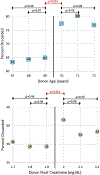Left-digit bias and deceased donor kidney utilization
- PMID: 33705569
- PMCID: PMC9162444
- DOI: 10.1111/ctr.14284
Left-digit bias and deceased donor kidney utilization
Abstract
Cognitive biases shown to impact medical decision-making include left-digit bias, the tendency to focus on a continuous variable's leftmost digit. We hypothesized that left-digit bias impacts deceased donor kidney utilization through heuristic processing of donor age and creatinine. We used US registry data to identify 87 019 kidneys recovered (2015-2019) and compared the proportion around thresholds for donor age (69 vs. 70 years) and creatinine (1.9 vs. 2.0 mg/dl), then compared the risk of kidney discard. Kidneys from donors aged 70 vs. 69 years were more frequently discarded (77% vs. 65%, p < .001), with higher risk of discard even after adjusting for KDRI (adjusted RR 1.11, 95% CI 1.02-1.21, p = .018). Similarly, kidneys from donors with final creatinine 2.0 vs. 1.9 mg/dl were more frequently discarded (37% vs. 29%, p < .001), with higher risk of discard after adjusting for KDRI (adjusted RR 1.19, 95% CI 1.07-1.33, p = .001). However, no significant left-digit effect was found when examining other donor age (39/40, 49/50, 59/60 years) or creatinine (0.9/1.0, 2.9/3.0 mg/dl) thresholds. The findings suggest a possible left-digit effect affecting kidney utilization at specific thresholds. Additional investigations of the impact of this and other heuristics on organ utilization are needed to identify potential areas for decision-making interventions aimed at reducing kidney discard.
Keywords: cognitive heuristics; decision-making; kidney donor; kidney transplantation; organ utilization.
© 2021 John Wiley & Sons A/S. Published by John Wiley & Sons Ltd.
Conflict of interest statement
Disclosures
The authors declare that they have no conflicts of interest to disclose.
Figures

References
-
- Royce CS, Hayes MM, Schwartzstein RM. Teaching Critical Thinking: A Case for Instruction in Cognitive Biases to Reduce Diagnostic Errors and Improve Patient Safety. Acad Med. 2019;94(2):187–194. - PubMed
Publication types
MeSH terms
Grants and funding
LinkOut - more resources
Full Text Sources
Other Literature Sources
Medical

